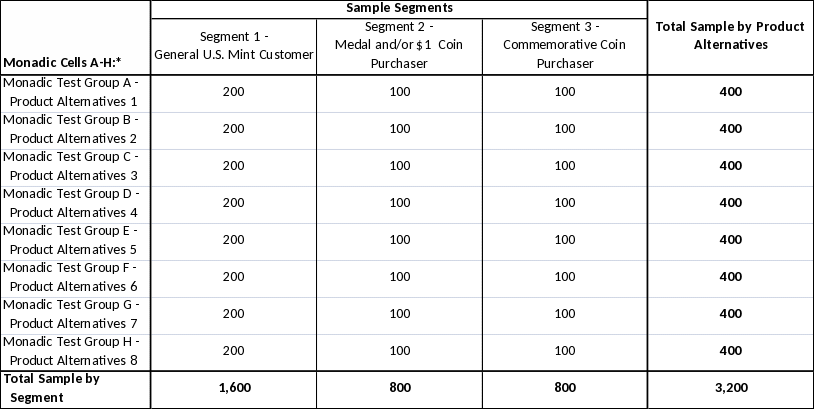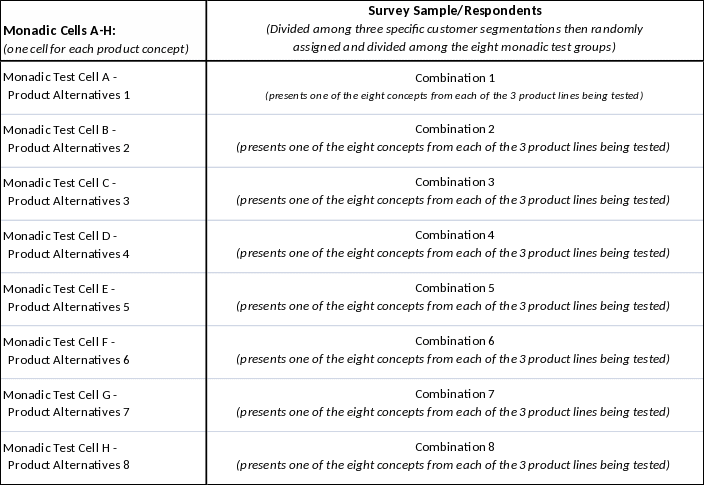1525-0012-0177 Justification
1525-0012-0177 Justification OMB Request_2013 Special Sets New Product Testing Survey_10 4 12.docx
Generic Clearance for Voluntary Surveys to Implement E.O. 12882
1525-0012-0177 Justification
OMB: 1525-0012
UNITED STATES MINT
QUANTITATIVE CONSUMER RESEARCH –United States Mint 2013 Special Sets New Product Testing Survey
10/4/2012
Introduction /Purpose of the Research
This collection request is for the United States Mint to conduct a new product research study testing the breadth and depth of customer interest in alternative concepts for a special product offering in each of three separate product lines in 2013. This study is similar to several recent quantitative new product assessments the United States Mint has undertaken. Conducting research to test interest in new product alternatives is imperative before investing substantial resources in developing a new offering or changing existing products and programs popular among coin collectors.
The United States Mint 2013 Special Sets New Product Testing survey is designed to assess customer interest in alternative executions of three new potential 2013 product offerings (i.e., a $1 Coin and Currency Set, a Teddy Roosevelt Coin and Medal Set, and a 5-Star General Set). The results from this research study will assist the United States Mint’s Brand Management Division in selecting and developing for sale in 2013 any or all three special products. The collection will help ensure customer interests and preferences inform the development of these potential 2013 special product offerings, which will in turn help ensure customer satisfaction and the investment of organizational resources are maximized.
Part of the United States Mint’s mission is to produce and make collectible coin products available directly to the American public. Executive Order No. 12862 (September 1993), titled “Setting Customer Service Standards,” establishes a mandate for the government to improve and adhere to best practices when providing customer service directly to the American people, such as by conducting research to determine satisfaction with existing services and to ensure the kind and quality of services offered are aligned with those the public wants (Section 1b). To effectively accomplish these goals, the United States Mint utilizes a combination of accepted research methods that shed light on the awareness, satisfaction and preferences among the public as they relate to collectible coin products and services. The United States Mint 2013 Special Sets New Product Testing survey is one of these instruments.
Conducting market research in advance of introducing new products and services, or before making changes to existing products and services, is vital to ensuring those decisions are likely to enhance customer satisfaction and maximize organizational efficiency. The United States Mint knows from experience, making new product and service decisions in the absence of collecting reliable information is likely to lead to undesirable outcomes in terms of customer satisfaction and organizational performance.
The consequences of not performing this collection are the United States Mint’s diminished ability to produce and offer collectible coin products that the public is interested in, and to maintain service levels that satisfy customers.
II. Sample Design and Methodology
The United States Mint 2013 Special Sets New Product Testing survey is designed to be web-based, with customers receiving an e-mail invitation to complete the survey. The targeted sample is a total of 3,200 respondents, which will include three different segments of United States Mint customers: 1) 1,600 general customers, 2) 800 customers who have purchased medals or $1 coins, and 3) 800 customers who have purchased commemorative coins in the past two years.
Because we are only considering offering a single alternative for each of the three product lines, and actual customers will not have knowledge of the other potential executions, the methodology utilizes a monadic cell design. The monadic cell design allows us to measure the appeal of a concept in absolute terms by testing a single alternative for each of the three product lines in which we are considering a special set among a randomly assigned sub-sample of the targeted sample segments. Respondents in each monadic test sub-sample report their interest in the single product alternatives presented across the three product lines. Their responses will thus be free of concept interaction since they will have no knowledge that other possible configurations are being considered in each of the three product lines. The reported interest for the alternative evaluated by each individual monadic sub-sample is then compared against the reported interests in alternatives evaluated by all the other monadic sub-samples to identify the most appealing option or options.
A matrix illustrating the monadic division of product alternatives across customer segment samples is as follows:

The sample for the survey will be obtained from the customer database lists. The sample will be selected randomly among the population of customers fitting the defined criteria. This will be a web-based survey of customers in general and two specific sub-segments of customers. Potential respondents will be sent email invitations to take the survey on-line. The survey should take no more than ten minutes to complete. Based on our historic response rates and our experience with this type of survey, we anticipate inviting 65,000 customers to respond to the survey in order to achieve the targeted 3,200 sample size. Collected survey data will be coded, cleaned, weighted and tabulated.
Survey Design
As stated, this will be a web-based survey taking approximately ten minutes to complete. The survey is designed to assess interest and determine the most appealing configuration among eight concepts each for following three product lines in 2013:
$1Coin & Currency Set
Teddy Roosevelt Coin & Medal Set
5 Star General Special Set
After asking several standard questions pertaining to screening, purchasing history and future intent (questions S1 – Q4b), the survey presents a set of three or four questions exploring interest in and likelihood to purchase a single concept in each of the three product lines being tested (Q5a-c, Q6a-d and Q7a-c). All respondents see these questions; however, which product concept they are responding to varies by which monadic testing cell they have been assigned to (monadic cell assignment is random within each sample segment). As shown below, respondents in each category will evaluate their interest in and likelihood to purchase a single permutation of each of the three types of potential products.

Following the concept assessment portion of the survey, all respondents are asked a set of standard demographic questions, after which they have completed the survey.
This monadic cell methodology is a research design commonly used in testing price sensitivity but is also useful in product concept testing where evaluation of concept appeal is desired in absolute terms, free from the bias inherent in comparative assessments The methodology does tend to increase the required sample size; however, it has the benefit of reducing respondent fatigue since the survey instrument is shorter (i.e., instead of each respondent evaluating all concepts for each product, they only review a single concept for each product). Obtaining unbiased assessments of the various product concepts is a research objective since it is more similar to the conditions in which we will ultimately offer any of these products – that is, we will only offer customers a single special product in each of the three product lines so customers will not know that the other choices existed. Additionally, since we are testing eight alternative concepts in each of three product lines, respondent fatigue would likely be an issue if all respondents were asked to assess all possible concepts. Using the monadic cell methodology, customers will only be asked to assess three product concepts, as opposed to twenty-four.
Methods to Maximize Response Rates
This survey approach is designed to minimize the amount of intrusion and burden that is placed on customers. Accordingly, calls will not be made to them, nor will other “intrusive” measures that normally might be used to maximize response rates. We plan to send e-mail invitations to customers explaining that participation is totally voluntary and that their feedback will be used to help improve the products and services we offer. Multiple reminder emails (e.g., two to three) will be sent to potential respondents to invite them to complete the survey. Respondents can complete the survey at a time convenient to them. No monetary incentive will be offered.
For United States Mint customers, we typically achieve very high response rates (4%-10% depending on the spend segment) even without an incentive. We keep surveys to a manageable length and field topics that are interesting and important to our customers. We ensure that our data provide reliable population-level inferences by carefully designing the sampling plan with appropriate strata and sample sizes and by weighting the data to account for the survey design and to adjust for non-response.
The United States Mint deals with non-response bias in a number of ways. First, question non-response (those who don’t answer a question but would otherwise complete the survey) is minimized by the survey tool, which requires respondents to make a selection for all questions. Second, survey non-response (people who don’t respond to the survey invitation and those who respond but don’t complete the survey) is minimized by keeping the survey short and as simple as practicable, allowing respondents to take the survey at a time convenient to them, and by sending reminder emails (usually one to two) to invitees who have not yet responded.
The monadic cell design utilized in the present study is likely to maximize response rates since it allows the survey to stay relatively short and simple and avoids requiring respondents to complete a long and potentially confusing survey asking them to make fine differentiations among a multitude of product concepts.
As with all of our research, to the extent that a non-response bias is or could be present in this study, we will attempt to identify it by comparing responses among early and late respondents, comparing responses among the targeted segments, and comparing responses along demographic lines. The United States Mint will account for non-response bias by weighting the survey data and applying other adjustment techniques appropriate and available.
Estimate of the Burden Hours
The collection of information will involve completion of the survey via the Internet with up to 3,200 randomly selected respondents. The average time to complete the survey will be approximately 10 minutes. Therefore, the total estimated burden for this survey is 533 hours.
-
FY13 Special Sets Survey
All respondents
3,200
Average minutes to complete survey
10 mins
Total estimated burden hours
533 hrs
If you have questions related to the review of this collection request, you may contact any of the following individuals at the United States Mint’s Sales and Marketing Department:
Kathy Chiarello – [email protected]; 202-354-7809
David Gessert – [email protected]; 202-354-7549
| File Type | application/vnd.openxmlformats-officedocument.wordprocessingml.document |
| File Title | Purpose of the Research |
| Author | Kathy Chiarello |
| File Modified | 0000-00-00 |
| File Created | 2021-01-31 |
© 2026 OMB.report | Privacy Policy